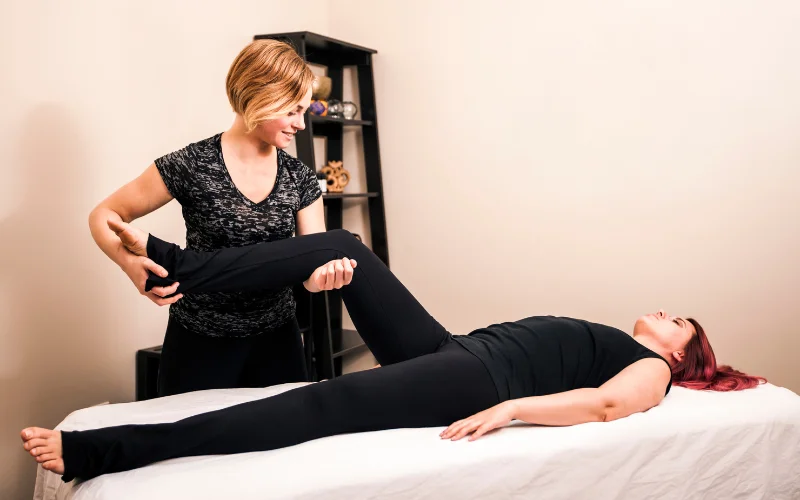Feeling disconnected from your body? You’re not alone! A staggering 70% of adults experience symptoms of disconnection from their physical selves at some point in their lives. But here’s the good news, somatic therapy exercises can help you bridge that gap and reclaim your sense of self. As someone who’s been through the transformative journey of somatic therapy, I can tell you firsthand that these exercises are game-changers. Ready to embark on a journey of self-discovery and healing? This article explores ten somatic therapy exercises, their benefits, and practical ways to incorporate them into your daily life.
What is Somatic Therapy?
Somatic therapy is a body-centered therapeutic approach that emphasizes the interplay between physical sensations and emotional experiences. Originating from the belief that the body holds onto stress and trauma, this therapy aims to help individuals release these stored emotions through mindful movement and awareness. For instance, addressing the before and after stress belly phenomenon can significantly impact one’s overall well-being.
10 Somatic Therapy Exercises

Somatic therapy exercises are designed to promote holistic healing by addressing the connection between the mind and body. Here are ten effective somatic therapy exercises that you can incorporate into your daily routine to improve your overall well-being.
Diaphragmatic Breathing
Diaphragmatic breathing, also known as deep belly breathing, involves taking slow, deep breaths into your diaphragm rather than shallow breaths into your chest. This technique helps activate the parasympathetic nervous system, promoting relaxation and reducing stress.
- Sit or lie down in a comfortable position.
- Place one hand on your chest and the other on your abdomen.
- Inhale deeply through your nose, allowing your abdomen to rise while keeping your chest relatively still.
- Exhale slowly through your mouth, feeling your abdomen fall.
- Repeat for several minutes, focusing on the rise and fall of your abdomen.
Body Scan
A body scan is a mindfulness practice that involves mentally scanning your body from head to toe, paying attention to any areas of tension or discomfort. This exercise enhances body awareness and helps identify areas that need relaxation or attention.
- Find a quiet place to sit or lie down.
- Close your eyes and take a few deep breaths.
- Slowly bring your attention to your head, noticing any sensations.
- Gradually move your focus down your body, part by part, until you reach your toes.
- Acknowledge any areas of tension and consciously release them.
Grounding Techniques
Grounding techniques involve connecting with the present moment through physical sensations. These techniques can help reduce anxiety and increase a sense of stability.
- Press your feet firmly into the ground and focus on the sensation.
- Hold an object and concentrate on its texture, weight, and temperature.
- Take a few deep breaths and notice the feeling of air entering and leaving your body.
Progressive Muscle Relaxation
Progressive muscle relaxation involves tensing and then relaxing different muscle groups in your body. This exercise can help release physical tension and promote a state of deep relaxation.
- Find a comfortable position and close your eyes.
- Start with your toes, tensing the muscles for a few seconds, then releasing.
- Gradually move up your body, tensing and relaxing each muscle group.
- Pay attention to the contrast between tension and relaxation.
Mindful Movement
Mindful movement exercises, such as yoga or tai chi, combine physical activity with mindfulness. These practices enhance body awareness, improve flexibility, and promote a sense of calm.
- Increases body awareness and mindfulness.
- Improves physical health and flexibility.
- Reduces stress and enhances overall well-being.
Somatic Experiencing
Somatic experiencing involves focusing on bodily sensations related to trauma or stress and allowing these sensations to be processed and released. This exercise can help alleviate trauma symptoms and promote emotional healing.
- Sit in a comfortable position and close your eyes.
- Bring your attention to any areas of discomfort or tension in your body.
- Allow yourself to fully experience these sensations without judgment.
- Notice any changes in the sensations and continue to focus on them until they dissipate.
Visualization
Visualization exercises involve imagining a safe and calming place or scenario. This mental imagery can help reduce stress and promote a sense of peace and well-being.
- Find a quiet place to sit or lie down.
- Close your eyes and take a few deep breaths.
- Visualize a place where you feel safe and relaxed.
- Engage all your senses to make the image as vivid as possible.
- Spend a few minutes in this mental space, allowing yourself to feel calm and peaceful.
Tapping (EFT)
Emotional Freedom Techniques (EFT), or tapping, involves tapping on specific acupressure points on the body while focusing on a specific issue or emotion. This exercise can help reduce emotional distress and promote emotional balance.
- Identify an issue or emotion you want to address.
- Use your fingertips to gently tap on the following points: the side of the hand, eyebrow, side of the eye, under the eye, under the nose, chin, collarbone, and under the arm.
- As you tap, repeat a phrase that acknowledges the issue and affirms self-acceptance, such as “Even though I feel [emotion], I deeply and completely accept myself.”
Sensory Awareness
Sensory awareness exercises involve focusing on specific sensory experiences, such as sounds, smells, or textures. These exercises can help ground you in the present moment and enhance overall sensory perception.
- Listen to the sounds around you and identify each one.
- Focus on the smell of a flower or essential oil.
- Touch different textures and notice how they feel against your skin.
Movement and Dance
Engaging in free-form movement or dance allows you to express emotions and release physical tension. This exercise can be a fun and liberating way to enhance body awareness and emotional expression.
- Releases pent-up emotions and reduces stress.
- Improves physical health and body awareness.
- Fosters creativity, joy, and a sense of freedom.
Somatic Therapy Exercises for Trauma

Dealing with trauma can be a challenging journey, but somatic therapy exercises offer effective tools for healing. These exercises are designed to help release stored trauma and restore balance in the body.
- Diaphragmatic Breathing: Inhale deeply through your nose, allowing your diaphragm to expand, and exhale slowly through your mouth.
- Body Scan: Lie down and mentally scan your body from head to toe, noting any areas of tension.
- Self-Massage: Use your hands to gently massage areas of tension, such as the neck, shoulders, and lower back.
Benefits of Somatic Therapy Exercises
Somatic therapy exercises offer a range of benefits for both physical and emotional well-being:
- Stress Reduction: Helps regulate the nervous system and reduce stress levels.
- Trauma Release: Assists in processing and releasing stored trauma.
- Enhanced Self-Awareness: Promotes greater awareness of bodily sensations and emotions.
- Improved Emotional Regulation: Helps individuals manage and regulate their emotions more effectively.
- Physical Health: Enhances flexibility, balance, and overall physical health.
Restoring Mind-Body Connection
The mind-body connection is crucial for overall well-being. Somatic therapy exercises help restore this connection by:
- Promoting Mindfulness: Encouraging awareness of the present moment and bodily sensations.
- Releasing Tension: Helping to release physical and emotional tension stored in the body.
- Enhancing Emotional Awareness: Allowing individuals to become more attuned to their emotions and how they manifest physically.
Role of a Somatic Therapist

A somatic therapist is a trained professional who guides individuals through somatic therapy exercises. Their role includes:
- Assessment: Evaluating the individual’s physical and emotional state.
- Guidance: Teaching and guiding clients through various somatic exercises.
- Support: Providing emotional support and creating a safe space for healing.
- Customization: Tailoring exercises to meet the specific needs of the individual.
How to Incorporate Somatic Therapy Exercises into Your Routine
Integrating somatic therapy exercises into your daily routine can be simple and rewarding. Here are some tips presented in a table format:
| Time of Day | Exercise | Description |
|---|---|---|
| Morning | Diaphragmatic Breathing | Begin your day with 5-10 minutes of deep breathing to center yourself. |
| Body Scan | Spend a few minutes mentally scanning your body to identify and release tension. | |
| Afternoon | Movement Breaks | Incorporate short yoga or Tai Chi sessions to break up your day and reduce tension. |
| Self-Massage | Use self-massage techniques to release tension in areas like the neck and shoulders. | |
| Evening | Expressive Arts | Engage in art or dance therapy to process your day’s emotions. |
| Box Breathing | Conclude your day with 5-10 minutes of box breathing to relax before bed. |
Conclusion
Incorporating somatic therapy exercises into your daily routine can have profound effects on your mental and physical well-being. These exercises offer a holistic approach to healing by addressing the interconnectedness of mind and body. Whether you are looking to alleviate stress, heal from trauma, or simply enhance your overall well-being, somatic therapy exercises provide valuable tools to support your journey. By regularly practicing these exercises, you can cultivate a deeper sense of self-awareness, emotional resilience, and physical relaxation. Embrace the power of somatic therapy and experience the transformative benefits it can bring to your mind and body.
FAQs
Can You Practice Somatic Experiencing by Yourself?
Yes, you can practice somatic experiencing on your own, although working with a trained somatic therapist can provide additional guidance and support. To get started with self-practice, begin with simple exercises such as diaphragmatic breathing or a body scan. These basic techniques are easy to learn and can be very effective in promoting relaxation and self-awareness.
How often should I practice somatic therapy exercises?
The frequency of practice can vary based on individual needs and preferences. However, incorporating somatic therapy exercises into your daily routine, even for just a few minutes, can yield significant benefits. Consistency is key to experiencing the full range of advantages.
Can somatic therapy exercises help with anxiety?
Yes, somatic therapy exercises can be highly effective in managing anxiety. Techniques like breathing exercises, grounding, and movement help regulate the nervous system, reduce stress levels, and promote a sense of calm and well-being.







